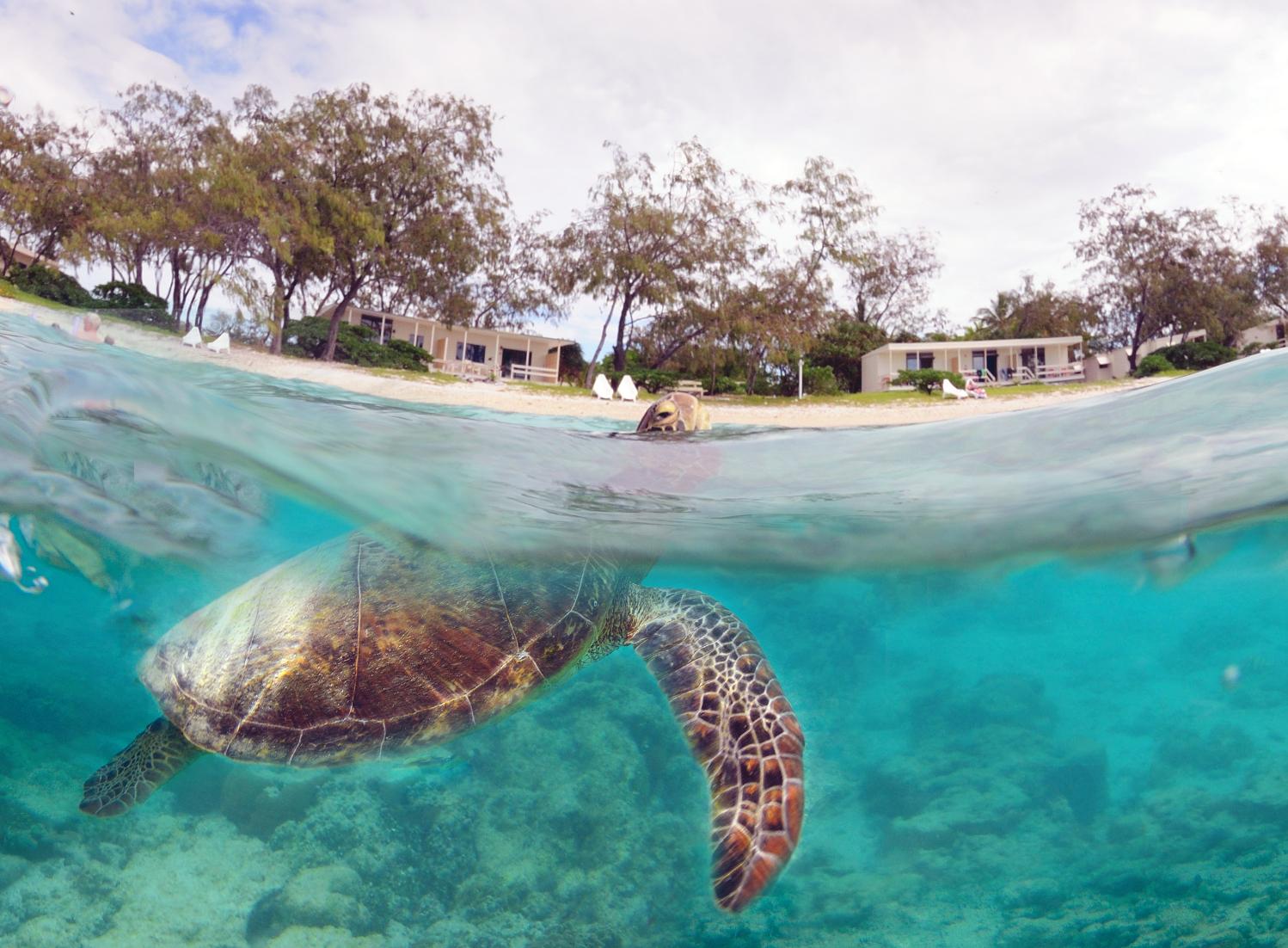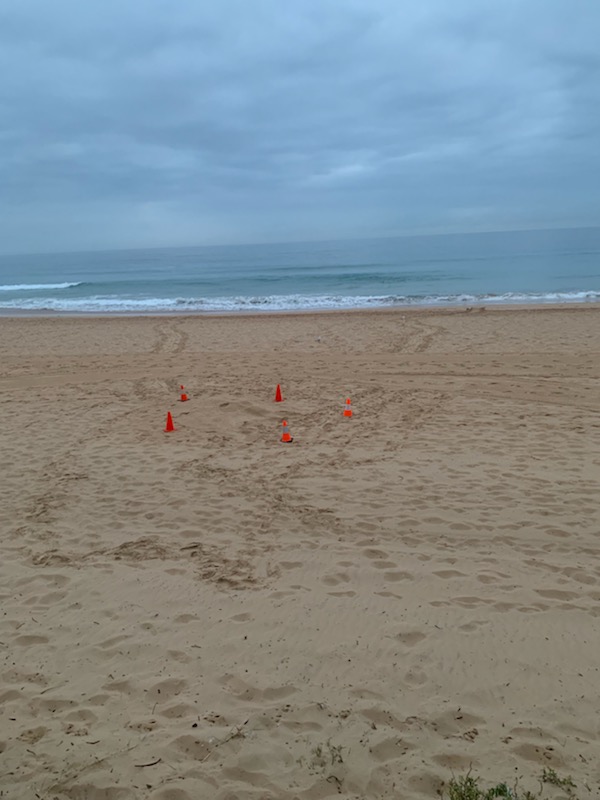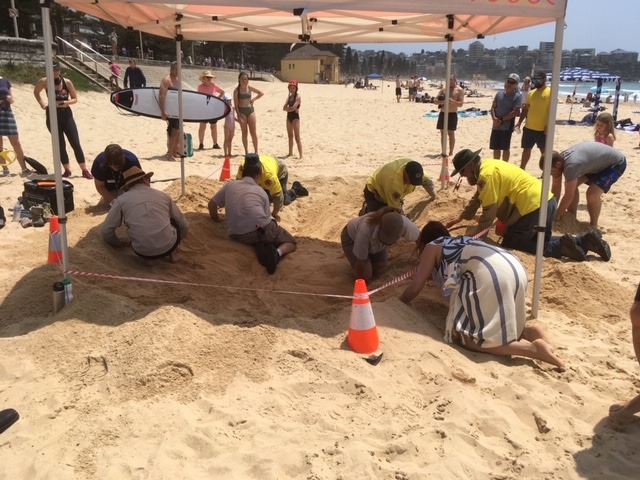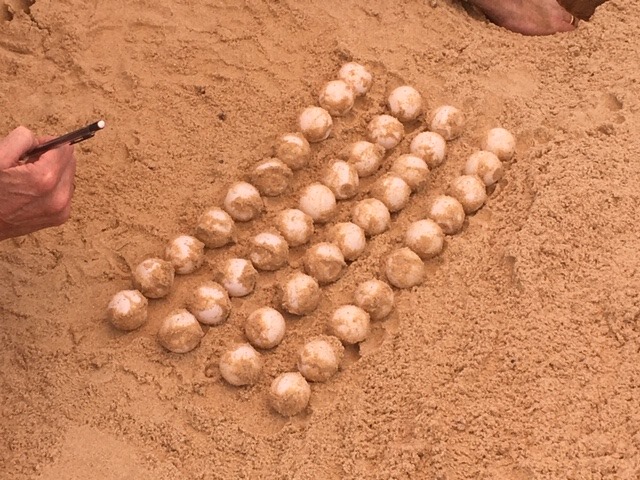August 8 - 14, 2021: Issue 505
NSW Shark Meshing (Bather Protection) Program 2020/21 Annual Performance Report: 90% Of Northern Beaches Marine Animals Entangled Were Not Targeted Sharks, Included Are Threatened Or Protected Species Mortalities

The annual NSW DPI NSW Shark Meshing (Bather Protection) Program 2020/21 Annual Performance Report was released at the beginning of this week, August 2nd.
The Shark Meshing (Bather Protection) Program (SMP) is a public safety measure introduced in 1937 to reduce the risk of shark interactions at the State’s most popular public bathing beaches. The meshing season runs from September 1st until April 30th of the following year.
Surf Life Saving NSW figures indicate that about 4.8 million people visited those beaches in 2020/21. Under the current program, 51 beaches between Wollongong and Newcastle are netted by seven contractors using specially designed mesh nets.
During the 2020/21 meshed period 728 inspections were carried out in the Sydney North region, which comprises Palm, Whale, Avalon, Bilgola, Newport, Mona Vale and Warriewood beaches. The Sydney Central region comprises North Narrabeen, Narrabeen, Dee Why, Curl Curl, Harbord, Queenscliff, North Steyne and Manly beaches where 832 net inspections took place.
The report shows a total of 375 marine animals were caught in the SMP during the 2020/21 meshing season, comprised of 40 target sharks and 335 non-target species.
The 40 target sharks comprised 24 White Sharks; 10 Bull Sharks; and 6 Tiger Sharks.
Of this 375 marine animals 144 (38%) were released alive, the other 231 (62%) were dead.
The 335 interactions with non-target species consisted of 158 non-target sharks, including Greynurse Sharks; a Great Hammerhead Shark; Smooth Hammerhead Sharks; Angel Sharks (Eastern Angel Sharks and Australian Angel Sharks); Port Jackson Sharks; Thresher Sharks; a wobbegong; a Pigeye Shark; *Broadnose Sevengill Sharks; *Whaler Sharks (Bronze Whalers, Common Blacktip Sharks, Dusky Whalers, Silky Sharks; Spinner Sharks; and an unidentified whaler species), and *Shortfin Mako Sharks; (* reported as target sharks prior to 2017), 137 rays, including Southern Eagle Rays; Australian Cownose Rays; Black Stingrays; White Spotted Eagle Rays; Manta Rays; a Smooth Stingray; and an unidentified Devil Ray (Mobula sp.), 18 marine reptiles comprised of: 8 Green Turtles; 5 Loggerhead Turtles; 2 Leatherback Turtles; 2 Hawksbill Turtles; and an Olive Ridley Turtle, 9 marine mammals comprised of: 5 Common Dolphins, 2 Humpback Whales; an Australian Fur Seal; and an unidentified dolphin species and 13 interactions with finfish (Australian Bonito, Frigate Mackerel, Mulloway, Longtail Tuna, and Yellowtail Kingfish).
Fifty-two (14%) of the interactions were with threatened species comprised of: 24 White Sharks; 9 Greynurse Sharks; 8 Green Turtles; 5 Loggerhead Turtle; 2 Leatherback Turtles; 2 Humpback Whales; 1 Australian Fur Seal; and 1 Great Hammerhead Shark. Nine (2%) of the interactions were with protected species comprised of: 5 Common Dolphins; 2 Hawksbill Turtles; 1 Olive Ridley Turtle; and 1 unidentified dolphin species.
Sixty-one of those 375 interactions with threatened or protected species, record in the 2020/21 meshing season:
- 24 White Sharks (17 dead, 7 released alive)
- 9 Greynurse Sharks (3 dead, 6 released alive)
- 8 Green Turtles (8 dead)
- 5 Common Dolphins (5 dead)
- 5 Loggerhead Turtles (5 released alive)
- 2 Humpback Whales (2 released alive)
- 2 Leatherback Turtles (2 dead)
- 2 Hawksbill Turtles (1 dead, 1 released alive)
- 1 Great Hammerhead Shark (dead)
- 1 Olive Ridley Turtle (dead)
- 1 Australian Fur Seal (dead)
- 1 unidentified dolphin species (dead)
In addition, there were 298 interactions with other non-target species, including:
- 137 Rays (35 dead, 102 released alive)
- 60 Smooth Hammerheads (58 dead, 2 released alive)
- 38 Bronze Whalers* (31 dead, 7 released alive)
- 15 Shortfin Makos* (14 dead, 1 released alive)
- 8 Broadnose Sevengill Sharks* (5 dead, 3 released alive)
- 6 Common Blacktips* (5 dead, 1 released alive)
- 6 Longtail Tuna (6 dead)
- 4 Dusky Whalers* ( 4 dead)
- 4 Angel Sharks (2 dead; 2 released alive)
- 4 Spinner Sharks* (4 dead)
- 3 Port Jackson Sharks (released alive)
- 3 Frigate Mackerel (3 dead)
- 2 Thresher Sharks (2 dead)
- 2 Mulloway (2 dead)
- 1 Silky Shark* (dead)
- 1 Wobbegong (dead)
- 1 Pigeye Shark (dead)
- 1 unidentified whaler shark* (dead)
- 1 Yellowtail Kingfish (dead)
- 1 Australian Bonito (dead).
* prior to 2017/18 meshing season, these species were reported as ‘target species’
Batoids (rays and skates) continue to comprise the greatest proportion of catches in the SMP at 37%, followed by Smooth Hammerheads at 16%, the collective group of ‘target sharks’ (Bull, White, and Tiger Sharks) accounted for approximately 11%, and Greynurse Sharks accounted for 2.4%.
Surf Life Saving (SLS) NSW reported 45 sightings in the Sydney region during the 2020/21 meshing season and 100 over all regions. The increased number of shark sightings for the period in this report reflects the use of drones by SLS NSW to conduct aerial surveillance over patrolled beaches in NSW as part of the three years of trials for this technology. This increase is unlikely to represent an increase in sharks along NSW beaches, but more likely to highlight the value of drone aerial surveillance in detecting sharks.
Contractors are required to check their set nets every 72 hours, weather permitting. This commitment was met on most occasions with 91% of set net inspections taking place within the 72-hour timeframe. The occasions where this requirement was not met, was due to severe weather conditions. The intention behind the 72-hour inspection timeframes under the current structure is to increase the chances of survival of any marine life caught in the nets.
The observer program was implemented with observers present on 39% of all net checks (hauls) undertaken by SMP contractors. Observers continued to focus on ensuring collection of biological samples in accordance with the Strategic Research and Monitoring Program. Biological samples were taken from 154 of the 231 animals found dead in the nets in 2020/21.
Those catches did not trip the trigger point for the objective of ‘minimising the impact on non-target species and threatened species’ in 2020/21.
Of the entanglements recorded in the Sydney North area species included 4 White Sharks and 2 Bull Sharks - targeted species, and non-targeted species comprising 9 Bronze whalers, 2 Dusky Whalers, 2 Makos, 1 Spinner shark, 1 Blacktip, 10 Smooth Hammerheads, 1 Great Hammerhead, 1 Greynurse shark, 1 Wobbegong, 1 Pigeye Sharek, 1 Manta Ray, 18 Southern Eagle Rays, 4 Australian Cownose Rays, 1 Smooth Stingray, 1 Whitespotted Eagle Ray, 1 Common Dolphin, 2 Loggerhead Turtles, 1 Leatherback Turtle and 2 Longtail Tuna, a total of 57 animals overall.
Of the entanglements recorded in the Sydney Central area species included 1 Tiger Shark, a targeted species, and non-targeted species comprising 1 Broadnose Sevengill, 1 Dusky Whaler, 1 Shortfin Mako, 1 Common Blacktip, 3 Smooth Hammerheads, 1 Southern Eagleray, 3 Australian Cownose Rays, 2 Common Dolphins, 1 unidentified dolphin, 2 Green Turtles and 2 Loggerhead Turtles, a total of 19 animals overall.
These numbers mean that of the 76 species entangled along the beaches from Manly to Palm Beach just 7 were targeted species, or 10%, and 90%, or 69 marine animals, were not.
The Central Coast South region accounted for 10 Smooth Hammerhead entanglements while the largest number, 21, were entangled in the Central Coast North region, which is Blacksmiths to Shelly beaches. These were also the same areas for the Green Turtle losses due to entanglements with 3 in the Central Coast North region and 2 in the Central Coast South region. The other 1 Green Turtle loss was recorded in the Hunter, which is the Redhead to Stockton stretch of beaches.
The 60 Smooth Hammerhead entanglements, with 58 dead, do indicate a significant drop of mortality for this species through the SMP entanglements when compared to the 2019/20 figure of 99, that of 2018/19 of 87 and the 112 of 2015/16. Under International Union for Conservation of Nature Red List Criteria, Scalloped and Great Hammerheads are listed as Endangered globally, the Smooth Hammerhead is listed as Vulnerable, while a fourth Australian resident, the Winghead Hammerhead (Eusphyra blochii), is Near Threatened.
The Green Turtle, (Chelonia mydas) has been assigned to the Partnership (widespread) management stream under the Saving our Species (SoS) program run by the NSW Environment Department. They are listed as Vulnerable in NSW and with the Federal Government.
NSW has responsibilities for the protection of green turtles under the Convention on the Conservation of Migratory Species of Wild Animals and for their joint management under the National Recovery Plan for Marine Turtles in Australia.
Rising global temperatures are having negative effects on threatened marine turtles world-wide (Jensen et al. 2018). NSW may be an increasingly important nesting region for green turtles (southern Great Barrier Reef population) and may prove vital to buffer populations from the effects of increasing temperatures from climate change by increasing the ratio of male turtles in the region.
Sea turtle nesting events in NSW are becoming more frequent, as seen in the January 2020 Green Turtle nest at North Steyne [2.], suggesting NSW beaches may play an increasingly important role as climate refugia. NSW beaches also offer refuge from other anthropogenic threats to marine turtles that are often associated with areas of high human population density and development (e.g. light pollution, disturbance), because nesting habitat in northern NSW coincides with relatively unpopulated parts of the east coast. [3.]
During the 2020/21 meshing season there were two reported shark-human interactions at meshed beaches of the SMP. A surfer was uninjured when bumped by an unidentified Whaler Shark at Queenscliff Beach in October 2020. Another surfer was also uninjured after being dragged backwards on his board while surfing at Cronulla Beach in March 2021. No injuries were sustained during these interactions so the trigger point for ‘reducing the risk to humans from shark attacks at beaches of the SMP’ was not tripped.
During the 2020/21 meshing season, there were also seven verified shark-human interactions at unmeshed beaches and one in a coastal lake. Two of those interactions occurred in the SMP region: a spearfisher was uninjured after encountering a White Shark at Deadman’s Cove, Maroubra, approximately 2km south of the nearest meshed beach at Maroubra; and a swimmer suffered serious injuries after being bitten by a Bull Shark in Lake Macquarie. There were also two unverified interactions in March 2021.
In 2020/21, DPI met all requirements of the Joint Management Agreement (JMA) and associated Management Plan. This Annual Performance Report did not identify a need for any specific amendments to the Management Plan or JMA, although they were both published in 2017 and will therefore be subject to review in 2022 in accordance with clause 9 of the JMA, which requires this to occur every 5 years.
However a statement released the same day as the Shark Meshing (Bather Protection) Program 2020/21 Annual Performance Report from the Australian Marine Conservation Society points out that over half the animals caught during 2020-2021 were threatened or protected species, and 80% (161) of these animals were killed.
To date, six out of eight NSW local councils with shark nets in their ocean beaches, including the Northern Beaches Council, have officially revoked support for the devices in order to make way for a modernised approach that will improve swimmer safety and significantly reduce environmental impacts. [1.]
Non-lethal solutions including drone surveillance, SMART drumlines, personal shark deterrents, and accessible education programs, are not only more technologically advanced but are also designed with nearly a century of advancements in understanding shark behaviour in mind. The Human Society International (Australia - HSI) and AMCS are hoping the NSW DPI will design a modern bather protection program relying on these more effective and sophisticated technologies and consigning the nets to history.
Lawrence Chlebeck, marine biologist for Humane Society International Australia, said: “Each year, we are heartbroken to see so many more marine animals lose their lives, all for the false sense of security provided by shark nets. The indiscriminate deaths that occur as a result of the outdated Shark Meshing Program in NSW must end. The technology is nearly 100 years old, we would never accept safety technology that old in any other facet of our lives, why should ocean safety be any different? It is in everyone’s best interest that the nets are done away with.”
Dr Leonardo Guida, shark scientist with AMCS, said: “The local communities want their beach safety standards modernised and the terrible cost to wildlife significantly reduced, if not eliminated altogether. Public sentiment and the science are in alignment – come September the NSW Government should keep the nets out and the drones up.”
Worth noting is that sixty White Sharks were tagged by DPI Fisheries between September 1st 2020 and April 30th 2021, seven of which were animals released from the SMP nets and the rest from SMART drumlines as part of the NSW Shark Program within which the SMP now sits. All of these seven SMP-released White Sharks were subsequently detected on acoustic listening stations administered through DPI Fisheries and/or the IMOS Animal Tracking Facility. One of these SMP-released White Sharks was fitted with a Pop-up Satellite Archival Tag (PSAT) which released from the shark after 1 month suggesting that the shark survived capture and release from the shark nets.
Analysis of movements from 77 satellite-tagged juvenile and sub-adult White Sharks indicated that they use the whole of the continental shelf down to depths of 350m on the continental shelf (Lee et al. 2021). Sharks were present over a wide range of sea surface temperatures (SSTs; 10-27°C) with the highest probability occurring at around 20°C. Sharks were more likely to exhibit area-restricted movement when SST was between 19 and 23°C, with moderate to high surface Chlorophyll-α concentrations and thermal and productivity fronts increasing their likely presence (Lee et al. 2021). These results imply that White Shark presence and dispersal may be linked, perhaps via prey distribution, to oceanic conditions. Identification of these conditions for nearshore distribution and abundance of White Sharks may assist as an input into decisions on the spatial and temporal allocation of shark bite mitigation measures.
There were no substantial increases in knowledge or research on Tiger Sharks occurring in NSW during 2020/21 that would affect the operations of the SMP. Target sharks released alive from the SMP are externally tagged with acoustic tags, as per procedures used by SMART drumline contractors in northern NSW, but only one Tiger Shark and one Bull Shark were alive, tagged, and released from the shark nets during the 2020/21 season.
During the 8-month reporting period 33 Tiger Sharks were tagged with acoustic tags as part of the broader NSW Shark Program. A total of 175 Tiger Sharks have now been acoustically tagged by DPI Fisheries. Two individuals were also equipped with pop-up satellite archival tags (PSATs). To date 16 Tiger Sharks carrying PSATs will provide data about movements and potential risk to bathers in NSW waters.
Bull Shark movement research continued in 2020/21 with one individual acoustically tagged during the meshing season, eight were internally tagged by DPI Fisheries scientists in Sydney Harbour, and 15 were externally tagged following release from SMART drumlines. A total of 181 Bull Sharks are currently acoustically tagged by DPI Fisheries.
The data has been used to determine the factors driving Bull Shark movements, leading to publication of three scientific manuscripts during the past year:
One publication combined acoustic telemetry and network analyses to investigate latitudinal and seasonal linkages of 73 sub-adult and adult Bull Sharks tagged in the Sydney and Townsville Reefs regions. Analyses indicate that movements of Bull Sharks varied according to their tagging location, with sharks tagged in Sydney exhibiting seasonal movements and limited residency times, while 35% of the sharks tagged in the tropics exhibited year-round residency on tropical reefs (Espinoza et al., 2021). Network analyses complemented these findings by revealing different seasonal habitat preferences between regions. Movement patterns of Bull Sharks tagged in Sydney Harbour were driven by seasonal temperature change, while tropical individuals appeared more driven by biological needs such as reproduction. These seasonal movements to and/or from distant bays and estuaries highlights the need for regional conservation approaches, and improved understanding of the degree of connectivity between habitats and latitudes.
The second publication highlights the value of telemetry studies in delineation of shark population structure. Here Australia-wide acoustic tracking data for 1,491 individuals of seven teleost and seven shark species, including Bull, Tiger and White Sharks, were used to asses stock structure and connectivity and compared to findings from genetic and conventional tagging. Network analysis revealed previously unknown population connections in some species, and in others bolstered support for existing stock discrimination by identifying nodes and routes important to connectivity, e.g., for Bull and White Sharks the network analysis showed movement patterns consistent with previous understanding of stock structure derived using genetic approaches whilst Tiger Sharks show structure within Australian waters, despite genetic evidence indicating panmixia, with individuals not connecting between east and west coasts of Australia (Lédée et al., 2021).
The third publication used SMP and commercial catch data for Bull Sharks, and determined that increase in occurrence of Bull Sharks over time was associated with seasonal variability of thermal gradients larger than 21°C and westward coastal currents stronger than 0.2 m.s-1 (Niella et al., 2020).
Predictive models using these results overlaid on CSIRO predicted change in oceanographic conditions along the east coast of Australia subsequently indicated that there will be an approximately 1° southward shift in the optimal thermal habitats favourable for year-round Bull Shark occurrence over the next 12 years (Niella et al., 2020). This will lead to a three month increase in the availability of favourable sea surface temperatures along the coast of NSW (i.e. from January-February to December-April) which could have implications for bather safety from shark bite.
The NSW DPI continued ongoing work during 2020/21 on the SharkSmart public awareness and education program including releases of updated versions of the SharkSmart App for iPhone and Android.
Although Covid-19 precluded face-to-face interactions with stakeholders, the DPI Fisheries Stakeholder Engagement team, managers and shark scientists held a series of online stakeholder forums with NSW coastal councils, surf lifesaving authorities, the ‘Bite Club’ (shark bite survivors) and scientists to provide feedback on the results from the five-year Shark Management Strategy.
Further information can be found on the DPI website at: www.sharksmart.nsw.gov.au
References
- Media Release from Northern Beaches Council, April 28th, 2021- below in full
- Green Turtles found Here to Head North, Issue 434, PON
- Green Turtle (Chelonia mydas) Saving our Species (SoS) program, NSW Office of Environment & Heritage
Council Calls For Removal Of Shark Nets On The Northern Beaches
Wednesday, 28 April 2021
Northern Beaches Council is calling on the NSW government to remove shark nets on beaches in the Council area and replace them with a combination of modern and effective alternative shark mitigation strategies that maintain or improve swimmer safety and reduce unwanted by-catch of non-target species.
Council made the call in response to the Department of Primary Industries – Fisheries (DPI Fisheries) request for input from stakeholders on their preferred shark mitigation measures, following a five-year project considering the benefits and impacts of a range of mitigation measures.
A number of residents addressed Council’s meeting last night in support of shark net removal, including surfing champion Layne Beachley.
A/Mayor Candy Bingham said Council considered both the need to maintain or improve swimmer safety as well as the negative impacts on non-target marine species in reaching their decision.
“The effectiveness of shark nets has been questioned by many, yet their impact on other marine species is devastating,” Cr Bingham said.
“We have an aquatic reserve in Manly where turtles and rays are regularly seen by snorkelers, and up and down the beaches dolphins surf the waves alongside local board riders.
“The research conducted by DPI Fisheries found that 90% of marine species caught in nets were non-target species and that sharks can in fact swim over, under and around the nets anyhow.
“If the evidence is that there are other just as, or more, effective ways to mitigate shark risk, such as drone and helicopter surveillance, listening stations and deterrent devices, then we owe it to those non-target species to remove the nets.
‘We will be providing that feedback through this consultation process and look forward to the government implementing effective shark mitigation measures while protecting other important marine species.”
________________________________________________________________
Green Turtle Eggs Found Here To Head North


